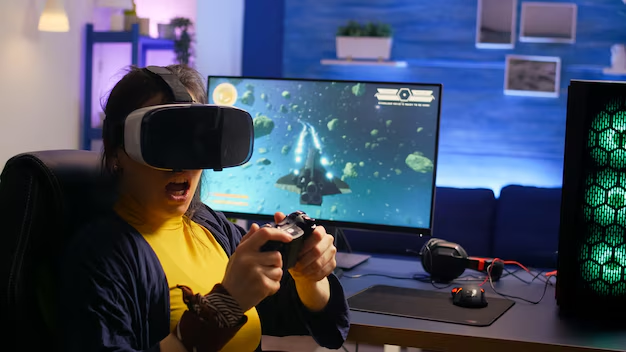The world of gaming has undergone a remarkable transformation over the last few decades. From the earliest days of arcade games to the latest innovations in virtual reality (VR), the gaming industry has continuously evolved, shaping entertainment, technology, and culture in ways few could have imagined. The evolution from arcade games to immersive VR experiences has been marked by groundbreaking advances in graphics, interactivity, and hardware, along with the growing influence of online gaming and mobile platforms.
The Birth of Arcade Games (1970s-1980s)
The evolution of gaming began in the early 1970s, with the introduction of arcade games. These early games were simple, often featuring basic graphics and straightforward gameplay. The most iconic and pioneering arcade game was Pong (1972), developed by Atari. Pong, a simple simulation of table tennis, became a sensation and sparked the first wave of arcade gaming.
Throughout the 1970s and 1980s, arcade gaming boomed with the release of titles like Space Invaders (1978), Pac-Man (1980), and Donkey Kong (1981). These games were housed in coin-operated machines that people played in arcades, bars, and various entertainment venues. Arcade gaming defined the early years of gaming culture, introducing the concept of competitive gaming and social interaction, as people gathered to compete for high scores.
The Rise of Consoles and PC Gaming (1990s-2000s)
As technology advanced, home consoles and personal computers became the next big thing in gaming. The 1990s saw the introduction of major gaming consoles like the Sony PlayStation, the Sega Genesis, and the Nintendo 64. These systems delivered more sophisticated graphics and gameplay experiences than arcade machines. Titles such as Super Mario 64 (1996) and The Legend of Zelda: Ocarina of Time (1998) pushed the boundaries of gaming, offering 3D environments and more complex narratives.
Meanwhile, PC gaming continued to evolve, with iconic games like Doom (1993) and Warcraft (1994) pushing the limits of graphics and networked multiplayer experiences. The online multiplayer scene began to flourish with the rise of games such as Quake and StarCraft, laying the groundwork for the online gaming communities that would dominate the 2000s.
In the 2000s, gaming took a further leap with the release of consoles like the Xbox 360 and PlayStation 3, offering high-definition graphics, online multiplayer, and a range of new game genres, from first-person shooters to open-world adventures. The Nintendo Wii also introduced motion controls, inviting more people into the gaming fold, including casual gamers who had never before been interested in traditional controllers.
The Mobile Gaming Revolution (2010s)
The 2010s marked the rise of mobile gaming, a platform that would dominate the gaming industry for years to come. The launch of the Apple App Store and Google Play Store allowed developers to reach millions of users with easy-to-access, casual gaming experiences. Mobile games like Angry Birds (2009) and Candy Crush Saga (2012) brought gaming into the pockets of everyday people, sparking an explosion in the casual gaming market.
The success of mobile games also paved the way for free-to-play models, in-app purchases, and social gaming experiences. The accessibility of mobile games, along with their variety and simplicity, made them appealing to people of all ages and backgrounds, further broadening the appeal of gaming.
Virtual Reality Gaming: The Next Frontier (2010s-Present)
In recent years, the gaming industry has experienced one of its most exciting advancements: virtual reality (VR). VR gaming seeks to immerse players in digital worlds by using specialized headsets and controllers that track their movements. With the release of devices like the Oculus Rift (2016), PlayStation VR (2016), and HTC Vive (2016), VR has brought a new level of immersion to gaming that traditional platforms could not match.
VR games like Beat Saber (2018), Half-Life: Alyx (2020), and The Walking Dead: Saints & Sinners (2020) have shown the potential of VR gaming to offer unique experiences that feel much more real and engaging than conventional video games. VR also opens the door to experiences beyond traditional gaming, such as virtual tourism, fitness, and social interactions within virtual worlds.
Despite the excitement surrounding VR, its adoption has been gradual due to factors like the high cost of VR headsets, the need for powerful gaming PCs, and some concerns about the comfort and accessibility of VR gaming. However, the technology continues to improve, with new devices becoming more affordable and the library of VR games expanding.
FAQs
- What was the first-ever video game? The first video game is commonly considered to be Tennis for Two (1958), developed by physicist William Higinbotham. However, Pong (1972) by Atari was the first commercially successful arcade game.
- How did arcade gaming influence modern gaming? Arcade games introduced the concept of competitive gaming, high scores, and social interaction. They laid the foundation for multiplayer experiences, which became a staple of later console and PC gaming.
- What is the difference between VR and traditional gaming? Traditional gaming involves playing on a screen with controllers, while VR gaming uses a headset and motion-tracking controllers to immerse players in a 3D virtual world, offering a more hands-on and immersive experience.
- What are some popular VR games? Popular VR games include Beat Saber, Half-Life: Alyx, Superhot VR, and The Walking Dead: Saints & Sinners.
- Why is VR not as popular as traditional gaming? VR gaming has faced challenges such as high costs, limited content, and the need for specialized hardware. Additionally, the immersive experience can cause discomfort or motion sickness for some users.
- How has mobile gaming impacted the industry? Mobile gaming has democratized gaming, making it accessible to a broader audience. It has also introduced free-to-play models and in-app purchases, fundamentally changing the way games are monetized.
- What is the future of gaming? The future of gaming includes further developments in VR, AR (augmented reality), cloud gaming, and AI-driven game design. Cross-platform gaming and social experiences will continue to evolve.
Conclusion
The evolution of gaming from arcade machines to virtual reality has been nothing short of extraordinary. What began with simple pixelated graphics and coin-operated machines has blossomed into a multi-billion-dollar industry that spans consoles, PC gaming, mobile platforms, and immersive VR experiences. Gaming continues to push the boundaries of technology, storytelling, and social interaction, promising even more innovation in the years to come.
Key Takeaway
The gaming industry has come a long way from its humble arcade beginnings. As technology continues to advance, we are on the verge of even more immersive experiences, whether through VR, cloud gaming, or mobile innovations. The future of gaming is bright, and with each new development, it is clear that gaming will continue to be a central part of our entertainment and cultural landscape.

